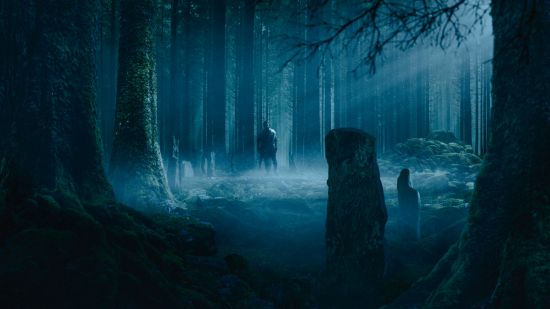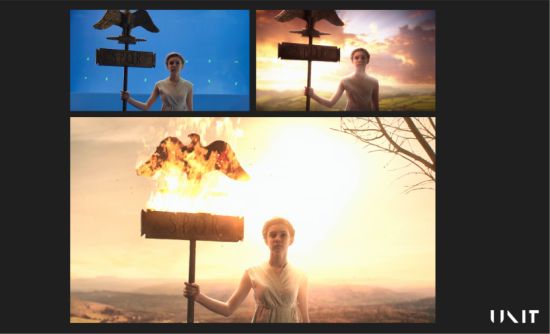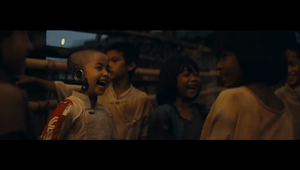
UNIT and UNIT Studios Deliver Stunning Post on Epic New Drama Britannia

UNIT and its TV and film division, UNIT Studios have collaborated on Sky Atlantic’s epic new historical drama Britannia, which was released on Thursday 18th January 2018.
With an award-winning cast and billed as one of Sky’s most ambitious series yet, the 9-part drama set in 43AD and sees Sky and Amazon Studios join forces for the first time in a co-production with Vertigo Films in association with Neal Street Productions.
At the helm was UNIT Studios' Executive Producer, Studios, Nicola Kingham, who comments: “We’re a relatively new TV & film division of UNIT and were approached back in February 2017 to work on a handful of VFX shots, but Simon Frame (the series' VFX Producing Supervisor), was so impressed with our collaborative and creative contribution that the shot count soon grew to over 300 shots. Notably, the Underworld, a high concept mythical location where the druids go to see the future and to communicate with their dead. Some studios might have been fazed by this but we knew we had a really strong team and were definitely up for the challenge."
UNIT’s Creative Director of CG, Nuno Pereira, oversaw the production from start to finish over four months and managed a streamlined pipeline with efficient workflows for a 3.2K ACES delivery. In light of the logistics, it was decided that the teams would be split and run in parallel. With Nuno overseeing the whole of production comprising 23 artists, Lead Designer Alon Ziv led a splinter team of two concept artists and one of UNIT’s in-house editors, Scott Ryan, devoted to creating the Underworld.
Nuno notes: “In the beginning, no one really knew what the Underworld was or what it was supposed to look like. It was an inherited sequence of loosely scripted dramatic performances by the actors, which had been shot against blue screen several months earlier catering for a simple line in the script which had read (we paraphrase here) 'Divis goes into the Underworld'. So, from a storytelling and editorial point of view there was a lot to be done."

In creating the Underworld environment Alon says, “The first challenge was to come up with a look and feel which clearly defined it. It somehow needed to be a mix between a drug-induced hallucination and a believable location. It was important to keep the reality of the Underworld vague because for the characters it’s a real place that changed and evolved every time the characters visited it, and what happens there has consequences in the real world. From a practical point of view, another challenge was to keep the actors eye lines and spatial placement believable in these new environments especially because they were shot before any of the environments where designed.”
Nuno adds: “Once concepts were approved, these shots were taken into production. Due to its nature, it ended up being a full VFX build with every shot, except for the actors, being fully computer generated. Our creative team worked on creature animation and simulations for the snake, with atmospherics and textures added in the smoke simulations and finally compositing. The team worked tirelessly to bring the concept art to life. The Underworld - albeit real - is heavily stylised so it was quite challenging to make it grounded and believable and not just an imaginary sequence parallel to the story.”
Scott Simmonds, one of UNIT’s Lead Nuke Compositors notes, "The biggest and most exciting challenge for me was bringing the 2D matte paintings to life, adding lighting, atmospherics, camera moves and parallax. The next challenge was then embedding our blue screen actors into the shot especially when the lighting was completely different. We had to really go in and mask off different body parts to either lighten or darken them in order to make the actors feel like they were shot in situ."
On grading the Underworld sequence, UNIT’s colour team enhanced the otherworldly graphic feel with strongly saturated and desaturated tones. In the end, UNIT created four sequences for the Underworld with around 100 shots in total. UNIT led and carried out all post-production, from concept art, to direction and editorial, FX, creature work, compositing and final grade.

Meanwhile, back in the ‘real world’, the second VFX team was working on two other sequences. The first, a druid initiation ceremony, where they were tasked with creating an optical Lensbaby effect. Parts of this sequence had been shot in camera but the remainder needed to emulate the shallow depth of field, stronger centres of focus and the distorted outer edges of the effect across some 80 shots.
The other sequence was Handfasting. Nuno comments, “This was a VFX heavy scene which incorporated a lot of invisible VFX over five minutes. This ritual marriage ceremony quickly turns sour and a battle ensues. Since this sequence was actually shot at different times, different days, with different lighting conditions it needed extensive work to create one seamless sequence. We were tasked with matching all the skies and the environments, then added smoke to the atmosphere (foreground, mid ground and background) balancing this with the existing smoke shots which had been shot on location. The battle sequence itself required clean up and removal, as well as the addition of blood, wounds and blood splatter."
On grading the Handfasting UNIT’s senior colourist Simon Astbury adds, “The biggest challenge was to match together an action heavy scene shot on three different days with four different cameras. To ensure a smooth flow of images in an action scene is difficult enough, but if you add varying weather and camera formats into the mix it becomes very challenging."
UNIT’s Executive Producer Emma Watterson finishes, “The collaborative manner of the project meant we had the clients trust throughout, which was a brilliant position to be in. We are all incredibly proud of the work on Britannia which has certainly pushed us creatively, especially with such a volume of work in such a short space of time, and raised the bar for the future VFX work we want to produce across the whole spectrum of TV, Film Commercials and Content."

Full Credits
Nuno Pereira: Creative Director of CG
Production
Nicola Kingham: Executive Producer
Emma Watterson: Executive Producer
Patrizia Mule: VFX Producer
Editorial
Scott Ryan: VFX Editor
Artists
Alon Ziv: Lead Designer, Underworld
Scott Simmonds: Compositor, Sequence Lead
John Kennedy: Matte Painter
Stephanie Joy: Compositor, Sequence Lead
Ashwini Prabhu: Compositor
Paul Sullivan: Compositor
Bence Varga: Compositor, Shoot Supervisor
Sandra Roach: Compositor
Enrico Lambiase: Compositor
Valentina Bartiromo: Compositor
Sam Meisels: Compositor, Sequence Lead
Pavel Vicik: Compositor
Jaime Fernandez: Creature Animator
Richard Nelson: 3D Animator
Craig Healy: 3D Animator
Will Davies: 3D Animator
David Knight: Houdini Artist
Tom Clapp: Compositor
Klaudija Cermak: Compositor, Sequence Lead
Vincent Goodsell: Compositor
Zissis Papatzikis: Compositor
Jorge Mazariegos: Compositor
Vincent Trollard: Compositor
U-Sun Hu: Compositor
Elizabeth Schuch: Concept Artist
Kirk Hendry: Concept Artist
Co-produced by Sky and Amazon
Production companies: Vertigo Films, Neal Street
Created by Jez Butterworth, Tom Butterworth and James Richardson
Executive producers: James Richardson, Sam Mendes, Pippa Harris, Nicolas Brown, Jez Butterworth and Anne Thomopoulos
Producer: Rick McCallum
Writers: Jez and Tom Butterworth, Richard McBrien
Series VFX Supervisor: Simon Frame













